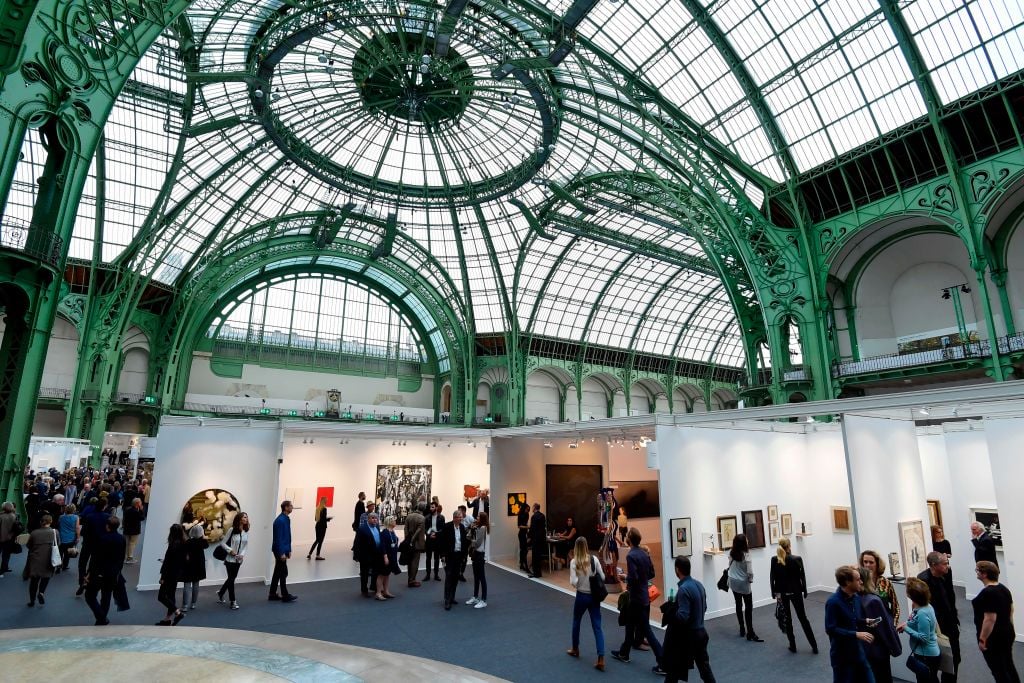
It’s been a long time coming. Younger and smaller galleries have been on the rocks for years, suffering from the costly participation in the art fair system. But that tide may be shifting in their favor: Several prominent art fairs, including Art Basel and Frieze, are now restructuring their booth pricing to accommodate galleries with different capacities.
Earlier this year, the international Paris-based fair FIAC quietly rolled out a pricing change for its upcoming 2018 edition and Frieze introduced its own new structure, which will debut at the fair’s Los Angeles chapter. This week, Art Basel revealed that it, too, is changing its pricing system for next year. And today, Germany’s Gallery Weekend Berlin adds to the chorus, announcing it is also revising its fixed price system. In each case, the fairs have introduced arrangements aimed at accommodating smaller galleries.
Most art fairs, of course, already have tiered pricing structures—the most expensive booths are usually in main gallery sections that see the most foot traffic, commanding a higher price; less expensive booths are set in less-trafficked areas. While this may be tenable for established galleries with larger coffers, the format has left out many smaller galleries that either can’t afford the cost or can’t incur the risk.
Earlier this week, Art Basel made headlines as the fair’s global director Marc Spiegler announced that, beginning in 2019, the fair will implement a progressive pricing system for booth fees, as well as other discounts, to ease the burden on young galleries. Getting underway at the flagship fair in Switzerland next year, dealers claiming larger booths in the main gallery section will pay a higher rate than those renting smaller booths.
In place of the current fixed price system within the main “Galleries” section, costs will now range from about $785 per square meter ($73 per square foot) for the smallest booths to about $934 per square meter ($87 per square foot) for the largest. In other words, the bigger the stand, the more the gallery will pay. Similar policies will also be introduced at Art Basel Miami Beach next year and Art Basel Hong Kong in 2020.
Without making an official announcement, Frieze had previously decided to try out a similar model for its debut edition of Frieze Los Angeles next February. Galleries taking part in Frieze LA will also pay more if they want a bigger booth. The fair has come up with four price bands, beginning with a smaller fee for stands measuring 20 square meters or 215 square feet (which will cost in total around $8,300), and increasing that fee in three progressive tiers, with the largest booths clocking in between 70 to 80 square meters (750–860 square feet) for $76,000. Frieze fairs director Victoria Siddall told The Art Newspaper, which first reported the change, that the organization is planning to roll out similar models in London and New York in the main section of the fair.
People walk through exhibits at the New York Frieze Art Fair on May 3, 2018 in New York City. Photo by Spencer Platt/Getty Images.
FIAC’s new model, which will be rolled out in the upcoming October edition, is slightly different. A spokesperson for the fair tells artnet News, “FIAC is not altering its pricing linearly but has instead opted for a system of incremental changes.”
For smaller-sized booths in the main section, the price per square meter has been lowered by five percent to €550 (or $638 for 10.7 square feet). For larger booths, the price per square meter is increasing by around 2.2 percent, being capped at a maximum of €650 ($754). The price for FIAC’s emerging galleries sector, which is already subsidized by 50 percent by the Lafayette Group, will remain at €290 ($336) per square meter.
In Berlin, Maike Cruse, the director of art berlin and Berlin Gallery Weekend, tells artnet News that pricing structure has been the subject of discussions for some time. To better support its spectrum of participating galleries, Cruse says the organization will introduce its own version of tiered pricing for 2019. It will also reduce participation fees for all its galleries.
The new system will also address VIP offerings. Previously, the organization gave each gallery access to 13 guests for its VIP program of exclusive services and events for a flat rate of €7,500 ($8,690). Now, it allows galleries to pay as little as €5,000 ($5800) for six guests. Every additional guest a gallery brings on will cost extra, and 13 guests will now be cheaper, costing €6,750 ($7845). In turn, galleries with more capacity are permitted to invite more VIPs—up to 20 guests or 30 guests—for a higher fee.
Earlier this year, organizers at New York’s Armory Show also changed the fair’s pricing system. This summer, it dropped booth rates by five percent across all exhibitor sections, as opposed to the usual rate increase of around four percent each year. Audrey Rose Smith, the fair’s director of communications, told artnet News that the move was a response to the growing concern among galleries about the cost of participation in art fairs.
This shift in pricing comes amid a rising chorus of criticism aimed at a system that has made it harder for younger galleries to stay afloat. The issue appeared to reach an inflection point last spring when veteran dealer David Zwirner proposed an art fair “tax” on top-tier galleries. Zwirner suggested that larger galleries like his should subsidize the cost of booths for smaller galleries at art fairs. Now, it seems, the talk is finally turning to action.
Update, September 6: An earlier version of this article incorrectly stated the timeline for Frieze’s new pricing structure. It was put in place earlier this year and covered by press this week, not established this week.